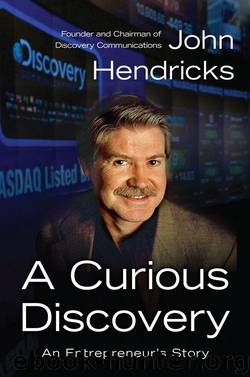A Curious Discovery: An Entrepreneur's Story by John S. Hendricks

Author:John S. Hendricks [Hendricks, John S.]
Language: eng
Format: mobi
Publisher: HarperCollins
Published: 2013-06-24T14:00:00+00:00
CHAPTER 21
Digital Dreams
Civilization advances by extending the number of important operations which we can perform without thinking of them.
—ALFRED NORTH WHITEHEAD
It was 1993. The dawn of a new era.
“Rupert has to see this,” John Malone said to me at the end of the demonstration.
“I agree. Fox is the only one not participating in the test.”
A few weeks later, John Malone and I arrived at Twentieth Century Fox Studios in Los Angeles. We had come to show Rupert Murdoch the future of television.
John Malone had started it all. And indeed, it seemed as if his entire career had brought him to this moment: engineering and economics degrees from Yale, a Ph.D. in operations research from Johns Hopkins, then Bell Labs when it was the cradle of communications innovation, then management training at McKinsey & Company. In 1970, Malone was named group vice president at General Instrument Corporation (GI) and soon thereafter he was named president of Jerrold Electronics, a GI subsidiary. Three years later he was hired as president and CEO of TCI—and then built that company into the cable television industry’s largest and most important distributor.
If the cable industry had a wizard, it was John Malone.
A Five-Hundred-Channel Universe
By the late 1980s Malone realized that television distribution would be dramatically more efficient if its analog signals were converted into digital transmissions that could be easily manipulated and compressed for efficiency. Specifically, in the same 6 megahertz (MHz) of spectrum required to send just one analog television channel feed, you could send as many as ten digital channels.
Meanwhile, the U.S. government was poised to adopt the Japanese MUSE analog standard for high-definition television. By doing so, the U.S. government not only would be surrendering leadership in television equipment manufacturing to the Japanese, it would also be enslaving itself to a “spectrum wasteful” form of analog communications for the indefinite future.
When John Sie learned of this he was horrified, as was his boss, John Malone. Sie went to hearing after hearing in Washington, explaining the folly of adopting an analog transmission standard in the age of computers. Slowly, he got converts—and in 1987, the FCC adopted a digital transmission standard. Through his tireless efforts, John Sie had almost single-handedly derailed the U.S. government’s adoption of an obsolete television standard—and deservedly earned his title as the “father of digital high-definition television.”
Throughout John Sie’s fight for digital television, he was on my board at Discovery, advising us on the potential of the technology. By 1990, John Malone began to attend our Discovery board meetings alongside the principals of each of our major cable shareholders, and between the two men they educated us on the power of digital. It proved to be a powerful head start.
It wasn’t until a cable trade show in Anaheim in late 1992 that John Malone famously coined the phrase “five-hundred-channel universe” to describe the digital future of television wherein 50 analog channels could potentially be converted into 500 digital channels. It had been a simple description of the 10x power of digital over analog, but John’s catchphrase caused a media firestorm.
Download
This site does not store any files on its server. We only index and link to content provided by other sites. Please contact the content providers to delete copyright contents if any and email us, we'll remove relevant links or contents immediately.
Hit Refresh by Satya Nadella(8854)
When Breath Becomes Air by Paul Kalanithi(8038)
The Girl Without a Voice by Casey Watson(7602)
A Court of Wings and Ruin by Sarah J. Maas(7251)
Do No Harm Stories of Life, Death and Brain Surgery by Henry Marsh(6683)
Shoe Dog by Phil Knight(4884)
Hunger by Roxane Gay(4677)
A Higher Loyalty: Truth, Lies, and Leadership by James Comey(4550)
The Rules Do Not Apply by Ariel Levy(4522)
Everything Happens for a Reason by Kate Bowler(4474)
Tuesdays with Morrie by Mitch Albom(4394)
The Immortal Life of Henrietta Lacks by Rebecca Skloot(4252)
How to Change Your Mind by Michael Pollan(4112)
Millionaire: The Philanderer, Gambler, and Duelist Who Invented Modern Finance by Janet Gleeson(4092)
All Creatures Great and Small by James Herriot(3981)
Tokyo Vice: An American Reporter on the Police Beat in Japan by Jake Adelstein(3860)
Elon Musk by Ashlee Vance(3854)
The Money Culture by Michael Lewis(3844)
Man and His Symbols by Carl Gustav Jung(3844)
